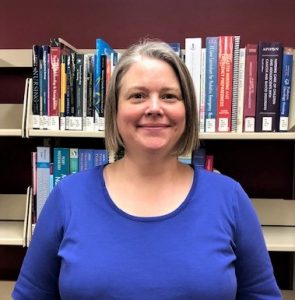Oct
21

Posted by Emily Hamstra on October 21st, 2019
Posted in: Health Observances, News from NNLM, News From NNLM PNR
Tags: interview, Medical Librarians Month
We continue our National Medical Librarians Month series with a profile of Sue Groshong, a librarian at Seattle Children’s Hospital in Seattle, WA.

Sue Groshong, librarian, Seattle Children’s Hospital Library & Information Commons
I met Sue Groshong at the Seattle Children’s Hospital Library & Information Commons on a sunny fall morning to talk with her about her experience as a hospital librarian. Sue is one of three librarians at the Seattle Children’s Hospital Library & Information Commons, a library that primarily serves medical staff, researchers, and other hospital employees. Sue has worked at Seattle Children’s 21 years and has held various roles within the library during her tenure. She’s currently responsible for library systems, interlibrary loan, cataloging, and is the library’s liaison to the hospital’s Clinical Effectiveness Program.
I asked Sue one of my favorite questions to ask librarians, “How did you become a librarian?” Sue has always been an avid patron of the public library, and in high school, became interested in genealogy. While in college, she worked in library technical services, and had an internship at the National Archives in Seattle. Later, she worked in a bookstore, and being a book person, applied for a staff position at the library at Seattle Children’s Hospital. While in the position at Seattle Children’s, Sue went to school for her library degree.
Sue shared with me some interesting and meaningful projects that she’s worked on. A few years ago, one of the hospital’s music therapists found a Reginaphone in a closet. The Reginaphone, made in 1902, had been used in the 1970s in the neurology department. The Reginaphone was played while children had EEG tests. The music therapist came to the library to learn more about the Reginaphone. With the help of interlibrary loan, Sue was able to locate information held in libraries and archives. The music therapist used this information to get the Reginaphone running, and digitally recorded the music. In addition to many memorable experiences at the library, Sue’s work makes an impact on clinical care. Sue and her coworkers complete do literature searches for teams across the hospital who are developing clinical pathways and care standards. Sue uses Ovid Medline, Embase, Cochrane, Trip, CINAHL, and other databases to gather the literature that informs the hospital’s standards. The standards created directly impact and improve the clinical care, spaces, and policies of the hospital. The day we met, Sue was working on a literature search on pneumonia.
I asked Sue about her favorite databases and resources. She recommends the Joanna Briggs Institute (JBI) Evidence-Based Practice Database as an excellent resource for new nurses or nurses who are new to doing research. The database provides evidence-based point of care resources, and is available via Ovid through subscription. She also highly recommends MedlinePlus for professional and personal use.
Sue clearly enjoys her work as hospital librarian, and after talking with her, I have a richer understanding of her day-to-day work as hospital librarian.